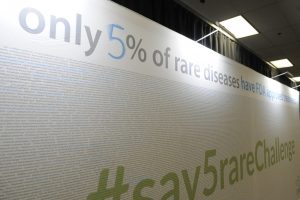#NORDsummit – Alternatives to Large Placebo Trials, Grant Awards Among Ways FDA Supporting Rare Diseases, Chief Says

Participants chat on the sidelines of NORD’s rare disease summit. (Photo: Larry Luxner)
More therapies are now available for the 30 million or so people with rare diseases in the U.S. than ever before, and millions of dollars are being invested in clinical studies that will test new ways of evaluating — and advancing — potential treatments, including the use of natural history models in trials.
Still, the path to regulatory approval for orphan drugs needs to be easier and quicker, said Dr. Scott Gottlieb, commissioner of the U.S. Food and Drug Administration (FDA). But efforts are underway to accomplish precisely that, and to ensure the Orphan Drug Act is allowed to work as intended.
Gottlieb, appointed to head the agency in May, addressed 670 delegates attending the Rare Diseases & Orphan Products Breakthrough Summit. The National Organization for Rare Disorders (NORD) sponsored the meeting, which took place Oct. 16-17 in Washington, D.C.
“The very landscape of rare disease product development is changing rapidly,” said Gottlieb, noting that the FDA’s Office of Orphan Products Development received 568 new designation requests in 2016, double the number in 2012.
“We need to make sure we can continue to build on the success of the Orphan Drug Act,” he said. “To address this challenge, I announced the FDA’s modernization in June — part of a broader innovation plan we’re working on to make drug development more advanced, predictable and modern.”
As part of that plan, the FDA has committed to provide more timely review while lowering the costs associated with orphan drug development and eliminating a backlog of requests, said Gottlieb, whose audience included representatives of more than 100 patient advocate groups — ranging from the Cystic Fibrosis Foundation to the Mitochondrial Disease Action Committee.
“The first of these goals has been fully achieved,” he said. “The FDA is spending $17 million to directly support rare disease clinical trials and, for the first time, natural history studies.
“Last week, we also announced funding for 15 new clinical trial research grants, including rare cancers.”
Gottlieb’s presentation at NORD came the same week the FDA approved Yescarta, a gene therapy developed by Kite Pharma — recently acquired by Gilead — to treat adults with aggressive forms of non-Hodgkin’s lymphoma who have undergone two unsuccessful chemotherapy regimes.
Critics of the Orphan Drug Act, however, continue to accuse pharmaceutical companies of misusing the act — taking existing therapies and essentially repackaging them to treat rare diseases to take advantage of the act’s largess.
“We need to dispel myth from fact in this regard. Some recent criticism is focused on the appropriateness of using an orphan designation for one disease and then repurposing it for another. The implication is that the orphans should not be used to promote something else, but we at the FDA disagree with that,” said Gottlieb.
“Patients with rare diseases deserve to have access to treatments, and the best way to ensure access is to study the drug in that rare disease, regardless of whether the drug is new or approved for another disease — and that it doesn’t block generics from entering the market,” he said.
“If a drug is already approved for one or more indication, and later received a rare designation, the Orphan Drug Act only protects the rare indication,” he added. “It doesn’t stop the FDA from approving a generic.”
Under the Orphan Drug Tax Credit, which faces opposition in Congress, pharmaceutical companies may earn tax credits for expenses incurred running clinical trials of potential therapies for the indicated rare, or orphan, disease. This credit lowers the cost of drug development.
“We are taking new steps to modernize our clinical approach to trial development and make it easier to enroll. This includes adopting clinical trial designs to reduce the need for large placebo arms and incorporate natural history models,” he said.
“The fact is, Congress is clearly directing the FDA to try to put drugs targeted to unmet medical needs through those pathways,” Gottlieb said. “We’re in a much different environment today than we were 15 or 20 years ago, and we can have more confidence today than we did in the past.”
Just before he spoke, NORD offered a sneak preview of a documentary put together as part of its “Do Your Share for Rare” campaign to raise national awareness of rare diseases. This summer, a team of NORD officials traveled to El Dorado, Kansas, to film the story of 11-year-old Peyton Madden, who is allergic to sunshine.
The boy is one of only 250 people known to suffer from xeroderma pigmentosum, an inherited skin order characterized by a heightened sensitivity to the DNA-damaging effects of ultraviolet radiation.
On Aug. 4, precisely at 8:45 p.m. — the stroke of dusk — the entire town transformed itself for Peyton, allowing him to enjoy a bike ride, a swim in the municipal pool, a pancake “breakfast” and live music. The event, dubbed “Good Morning Peyton,” was a collaboration between El Dorado officials and NORD.
“Through this project, the town came together to turn evening into morning,” said Mary Dunkle, NORD’s vice president of educational initiatives. “It’s NORD’s hope that we can inspire others to get involved — in ways big and small — by sharing stories like this one.”









